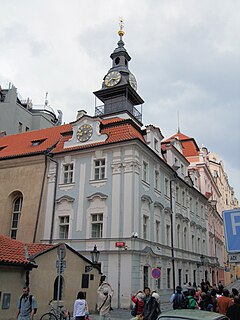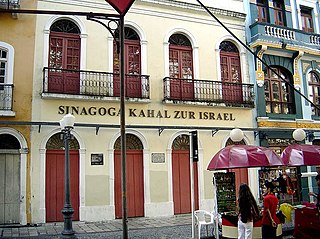
The Paradesi Synagogue is the oldest active synagogue in the Commonwealth of Nations, located in Kochi, Kerala, in South India.(The first synagogue in India was built in the 4th century in Kodungallur when the Jews had a merchantile role in the South Indian region along the Malabar coast. When the community moved to Kochi in the 14th century, it built a new synagogue there.) Constructed in 1568, it is one of seven synagogues of the Malabar Yehudan or Yehudan Mappila people or Cochin Jewish community in the Kingdom of Cochin. Paradesi is a word used in several Indian languages, and the literal meaning of the term is "foreigners", applied to the synagogue because it was built by Sephardic or Portuguese-speaking Jews, some of them from families exiled in Aleppo, Safed and other West Asian localities. It is also referred to as the Cochin Jewish Synagogue or the Mattancherry Synagogue.

The history of the Jews in Prague is one of Central Europe's oldest and most well-known. Prague boasts one of Europe's oldest recorded Jewish communities, first mentioned by an Mizrahi-Jewish traveller Ibrahim ibn Yaqub in 965. Since then, the community never ceased to exist, despite a number of pogroms and expulsions - and the holocaust and subsequent antisemitic persecution by the Communist regime in the 20th Century. Nowadays, the Jewish community of Prague numbers approximately 2,000 members, although the number of Jews in the city is probably as high as 10,000 but for various reasons they remain officially unregistered as such. There are a number of synagogues of all Jewish denominations, a Chabad centre, an old age home, a kindergarten, Lauder Schools, Judaic Studies department at the Charles University, kosher restaurants and even a kosher hotel. Famous Jews from Prague include the Maharal, Franz Kafka, Miloš Forman and Madeleine Albright.
The history of the Jews in Indonesia began with the arrival of early European explorers and settlers, and the first Jews arrived in the 17th century. Most of Indonesian Jews arrived from Southern Europe, the United Kingdom, the Netherlands, Belgium, Germany, France, Middle East, Northern Africa, India, China and Latin America. Jews in Indonesia presently form a very small Jewish community of about 100–550, of mostly Sephardi Jews. Judaism is not recognized as one of the country's six official religions, and members of the local Jewish community have to register as Christian or another recognized religion on their official identity cards.
The history of the Jews in Trieste, Italy goes back over 800 years.

The history of the Jews in Albania dates back about 2,000 years. According to historian Apostol Kotani : "Jews may have first arrived in Albania as early as 70 C.E. as captives on Roman ships that washed up on the country's southern shores...descendants of these captives that would build the first synagogue in the southern port city of Sarandë in the fifth century...[but] Little is known about the Jewish community in the area until the 15th century."

The Old Synagogue in Dubrovnik, Croatia is the oldest Sefardic synagogue still in use today in the world and the second oldest synagogue in Europe. It is said to have been established in 1352, but gained legal status in the city in 1408. Owned by the local Jewish community, the main floor still functions as a place of worship for Holy days and special occasions, but is now mainly a city museum which hosts numerous Jewish ritual items and centuries-old artifacts.

Kahal Zur Israel was a Jewish synagogue located at Rua do Bom Jesus number 197 in Recife, Brazil. It was established in 1636 by Portuguese and Spanish Sephardic Jews that had taken refuge in the Netherlands fleeing forced conversion and were joined by New Christians, who possibly helped to build the structure and were already living in the colony. It was the first synagogue erected in the Americas. The building is now a museum, including a Torah and bema as well as archeological excavations displaying various parts of the original synagogue, such as the mikveh.
The history of the Jews in Turin, Italy, can be first traced to the 4th century when bishop Maximus of Turin recorded the presence of Jews in the city. The city of Turin is in north-west Italy and is the capital of the Piedmont region.

The history of the Jews in Ústí nad Labem in the Czech Republic dates back to 1848, following the emancipation of Austrian Jews. The greatest expansion achieved owing to presence of two significant families, who contributed to city development, at the end of 19th and at the beginning of 20th century. Two following dictatorships had devastating effect on the community. Most Jews fled prior to or during World War II. In November 1938, after the Munich Agreement, the few Jews that remained in Ústí were sent to extermination camps.

The history of the Jews in Naples deals with the presence of Jews in the city of Naples, Italy. The Jewish presence in the city goes back at least 2,000 years. Today, the Jewish community in Naples numbers around 200 people.
The history of the Jews in Munich, Germany, dates back to the beginning of the 13th century. An early written reference to a Jewish presence in Munich is dated 1229, when Abraham de Munichen acted as a witness to the sale of a house in Ratisbon.
The history of the Jews in Vienna, Austria, goes back over eight hundred years. There is evidence of a Jewish presence in Vienna from the 12th century onwards.

The history of the Jews in Innsbruck, Austria, includes a number of communities such as the Israelite Community of Tyrol and Vorarlberg that are located in Innsbruck.

The history of the Jews in Florence can be traced over nine hundred years. Florence is the capital city of the Italian region of Tuscany and of the province of Florence. The Jews of Florence have one of the oldest continuous Jewish communities in Europe. The historic Jewish community in Florence is one of the largest and one of the most influential Jewish communities in Italy. The Jewish community in Florence also serves the smaller neighboring Jewish communities in Pisa, Livorno, and Siena.

Jews lived in the northern Hungarian town of Verpelét and the surrounding Heves county from the 15th century or earlier up to the late 17th century, after which they were excluded from the area. During the 19th century the Jewish population increased in the area, with 174 living in the town itself in 1880. Hungary's only wooden synagogue was in Verpelét. Jewish students also travelled in to study at the yeshiva established there in the early 20th century, which was closed down by the government in 1942. In 1944 under the German occupation the Jews of the area were sent for forced labour or killed at Auschwitz; only eleven returned to the town, and the synagogue has been converted for other use.

The Great Synagogue in Lutsk, Ukraine, is a Renaissance building with a tower. Located in the Jewish quarter, it was the religious, educational and community centre of Lutsk Jews until the invasion of Poland in the Second World War. It was built in 1626 and is a good example of a fortress synagogue. Partially destroyed in 1942, the synagogue was restored in the 1970s. It is now used as a sports club.
The history of the Jews in Aruba can be traced back to the 16th century, when the first Jewish immigrants began to arrive. The first Jews in Aruba were Sephardi Jewish immigrants from Netherlands and Portugal. The first Jew to settle in Aruba was a Portuguese-Jewish worker for the Dutch West Indies Company named Moses Solomon Levie Maduro, who arrived in Aruba with his family in 1754.
The history of the Jews in Ancona in Italy, began when Jews settled into the city in the first half of the 14th century, contributing to money-lending and other economic roles.

The Jewish community of Oldenburg in northwest Germany was established as early as the 14th century. It existed consecutively ever since, except for occasion deportations by the local rulers of the Duchy of Oldenburg and the Holocaust, which annihilated the majority of Jews left in the city in the 1930s. Nevertheless, after the Holocaust, Jewish survivors have returned and resettled in the Oldenburg Jewish community, which nowadays operates actively within the Central Council of Jews in Germany, the fastest growing Jewish community in the world.













